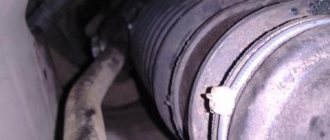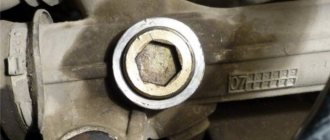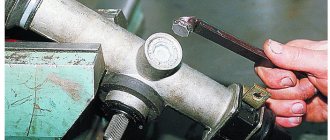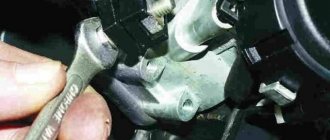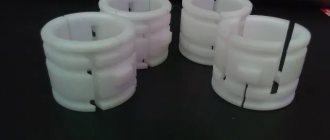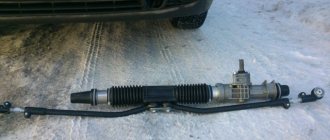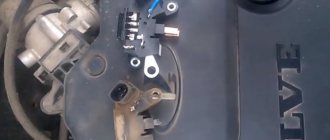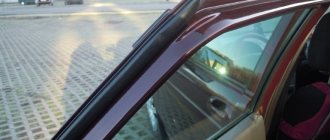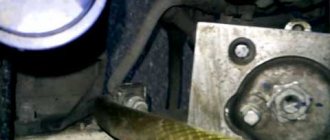When does the steering rack need to be tightened on a Priora?
The first sign indicating the need to adjust the rack is the appearance of a knocking sound when driving over small uneven surfaces. The knocking will be felt especially clearly when driving on country roads. In this case, the driver will feel shocks and vibrations on the steering wheel, which will also be transmitted to the entire car body.
In addition, if the steering wheel adjustment nut is loosened when driving on the highway, the car will “float” a little, and additional steering will be required from the driver, which will also immediately become noticeable.
Experts also say that a tightening is necessary if the driver begins to notice the appearance of a clearly audible crunching sound in the area of the steering column, as well as an increase in the amplitude of the steering wheel rotation.
Symptoms of steering “disease”
How to tighten the steering rack on Priora and Kalina? Why exactly these two models are combined is because they have an identical system structure. How do you know when the steering mechanism needs to be serviced?
- Constant beating of the steering wheel, even on a flat road;
- Poor car control when entering a turn;
- Reported crunch in the column area;
When tightening doesn’t help and the mechanism needs to be changed
It’s worth thinking about replacing the rack when tightening it does not in any way affect the car’s behavior on the road, and also does not help get rid of the unpleasant knocking noise. A failed steering rack will cause significant play in the steering wheel. Moreover, it may begin to jam (this happens extremely rarely, but similar cases are known). If the rack begins to jam, then it is better to stop using the car, as this can lead to the most dire consequences.
You cannot do without a replacement even if after tightening it you managed to get rid of knocks and vibrations, but they reappeared later.
Some operating tips
To make a full repair, you need to have not only knowledge and a sufficient set of tools, but also time. If you don’t have anything, it’s better to contact a car service. But their services are not cheap, so in order not to visit them often with the same problem, you should adhere to these simple rules:
- Try not to run over curbs and rails. This leads to cracks appearing on the rail. But most importantly, the steering shaft may become deformed.
- Try to twist the steering wheel to extreme positions as little as possible. This contributes to very rapid wear of the car's steering elements.
- Be sure to monitor the condition of the anthers. If they have cracks or cuts, replace them as quickly as possible. It's cheaper than replacing the entire rack.
- If your car has a hydraulic booster, be sure to keep track of what kind of fluid is in it. If it leaks or changes color, this will cause the Priora steering rack to break.
Be sure to carry out a complete diagnosis of the vehicle's suspension, steering and braking system. This way you will ensure that the car is operated as safely as possible.
What is needed for work and how to tighten the steering
To perform the tightening you will need the following tools:
- Slotted screwdriver (in simple terms, a “flat” screwdriver);
- Wrench 13;
- A special 17mm wrench designed to adjust the steering rack.
To make the work more comfortable and faster, it is recommended to drive the car into a special inspection hole or overpass, and also use an assistant, whose role even a child can handle.
To get to the rail, you should perform a number of simple steps:
- Disconnect the battery terminals and dismantle it;
- Using a 13mm wrench, unscrew the bolt securing the battery stand, and then remove it;
- Directly under the steering rack, using a slotted screwdriver, you need to pull out the small plug of the adjustment system.
After this, you will have access to the nut responsible for adjusting the thermal gap in the rail.
Next, you need to put your hand under the steering rack and try to put the rack wrench on the nut. It is necessary to tighten the nut clockwise, but since the rack itself is located upside down, from the outside it may seem that the nut must be tightened counterclockwise. Experts recommend tightening the nut no more than 25–30 degrees at a time, after which you should try to rotate the steering wheel, which should turn without jerking or biting.
It is also necessary to listen to the sounds coming from the steering wheel - if there are no knocks when turning the steering wheel, and there are no other noises, then the rack is tightened correctly, and you can put the battery and rubber plug in their place.
The tightening process on video
Tools for repairs
In order to independently repair the Priora steering rack, you will need certain tools and equipment. In particular, the following tools are needed:
- Slotted screwdrivers (flat).
- Spanners, open-end wrenches, heads 13.
- Special wrench 17 for adjusting the steering rack.
In order to complete all the work as quickly as possible, you need to install the machine on an inspection hole, lift or overpass. Help won't hurt you either, so you should have a partner. He will not be required to know the components and assemblies of the car, so you can use the help of your child or wife.
How to tighten the steering rack
Before we begin describing this repair, if it can be called such at all, let's look at the main reason why you have to tighten the steering rack on a Priora.
So, I think that many owners know that when a knock appears from the steering rack or its rod, it is necessary to make an adjustment, or rather, tighten the rack using a special nut, which is located on the inside of the case, which is clearly visible in the photo below.
To understand where this nut is located, look at the photo below, everything is shown from above - from the hood side, of course, in this case this nut is located on the reverse side:
To get to this adjusting nut, you will most likely have to remove the battery, since without it there is more free space under the hood. Although the good news is that even the battery in the Priora does not interfere with this repair (unlike cars such as Kalina or Granta).
It is worth noting that you may need the following tools for work:
- 10mm wrench or socket wrench
- key for 13
- the key for tightening the rack is exactly 2110 and not 2108
Now, using a special key from the inside, as shown in the photo below, insert it into the hole:
It is enough to make less than half a turn, and then try the play on the rods. If it disappears and there is no more knocking, then there is no point in tightening it further, since you can overdo it, and in this case the rail may bite. For a more visual example and description of the entire procedure, watch the video report below.
Replacing bushings
It happens that tightening the central nut of the steering wheel does not help. The steering wheel continues to “beat”. In this case, the triangular bushings on the steering wheel rod should be replaced. To do this you need:
- Inspection hole, set of keys;
- Remove the steering wheel by unscrewing the four fastening bolts and remove the mechanism from the engine compartment;
- Clamp in a vice and place subsequent parts on a clean, dry surface. This could be a newspaper or a rag;
- Remove the boot, unscrew the two bolts that hold the steering rack “worm”, pull it out;
- Pull out the rail itself with the bushings;
- After removing the old ones, install new plastic bushings on the rail. At the same time, carry out a visual diagnosis of the integrity of the mechanism. If the teeth are damaged, urgent replacement is necessary;
- We install new bushings, add lubricant, preferably graphite. Putting the mechanism back together;
- Next we carry out the procedure described above for tightening the steering wheel.
Minor repairs require more than one hour. If the car has not been used for a long time, for example, in winter, then after the first trips, breakdowns in the steering rack are also possible. This is due to plastic bushings, which are very fragile and susceptible to the negative effects of temperature changes.
Remember to purchase spare parts and repair kits only from certified points of sale. The better the quality of the part, the longer its service life. So, how to tighten the steering rack on Priora and Kalina is now clear. On average, the mechanism lasts no more than 30,000-40,000 km. until complete renovation. Good luck to you on the roads.
About the rake
The steering mechanism on Lada cars, starting with model 2108, has a steering rack. It is designed to move steering rods along a horizontal plane, which helps turn the car's wheels.
The design of the slats is quite simple and reliable, with the exception of one small drawback - a plastic bushing.
This bushing is made by the manufacturer from low-quality plastic, which soon leads to play in the rasp in it and the appearance of an unpleasant knock when moving on paving stones.
There is a rail between the engine and the passenger compartment, perpendicular to the exhaust manifold and attached with two brackets to the engine shield.
Eur
But more often there are mechanisms with EUR, they include:
- Frame;
- Seals and seals;
- The rack is mobile;
- Metal casing;
- Splined shaft with bearing;
- Springs;
- Rubber cover.
The most important part of all of the above is the moving rail. It consists of a metal pin hidden inside a metal casing. On one side of it, teeth are visible, located at an equal distance from each other. These teeth contact the steering gear teeth at right angles. That is, when the driver turns the steering wheel, force is transmitted to the shaft, which drives the rack. It moves under the influence of force in the casing, changing the pressure on the steering rods so that during a turn the wheels turn so that the car turns smoothly and without jerking.
Design
Steering rack design: 1 – shaft boot, 2 – cover mounting bolts, 3 – Belleville washer, 4 – worm shaft oil seal, 5 – worm gear cover, 6 – sealing collar, 7 – thrust bearing, 8 – worm shaft with bearing, 9 – rasp, 10 – left boot, 11 – binoculars, 12 – binocular bracket, 13 – nut plug, 14 – thrust nut, 15 – thrust spring, 16 – locking collar, 17 – thrust piston collar, 18 – thrust rasp piston, 19 – piston liner, 20 – steering rod bolt, 21 – stopper, 22 – plate, 23 – plastic clamp, 24 – steering rack boot, 25 – left side boot, 26 – steering rack pipe.
Signs of play in slats
When driving over small irregularities such as a gravel road, shocks and knocks in the suspension are clearly audible and are transmitted to the steering wheel. These signs will not always refer to play in the rack. Similar impacts to the steering wheel can occur due to broken steering ends or a broken crosspiece of the steering mechanism. Before you begin repairing the rack, you must exclude the tips and steering cross from suspicion.
- Impacts to the steering wheel when driving over bumps
- Creaking sound when turning the steering wheel
- Biting the steering wheel in different positions
- The steering wheel does not return to zero position
Checking for play
Checking for play is done by rocking the swing arms up and down. To do this, we find the steering rods under the hood and pull each of them up and down; there should be no play or knocking. If any, then the rack should be maintained.
Gur
The entire set of rack with power steering for Lada Priora contains:
- Oil tank;
- High and low pressure hoses;
- Steering mechanism with built-in power steering of the rack-and-pinion type;
- Vane type oil pump.
The power steering operation process is similar to the movement of a piston in a hydraulic cylinder: when the pump pumps out working fluid, it pushes the pistons, reducing the required driver effort to turn the wheels. At the same time, it is not for nothing that the power steering is praised for the fact that it leaves the driver the opportunity to feel the road, because with a torsion-type switchgear it acts on the pistons with exactly the same pressure that prevents the steering wheel from turning freely, and nothing more. Based on this, the greatest pressure in the system generally occurs when the car is stationary - that is, when the driver makes the greatest effort to turn the wheels.
When driving at speed (for example, in case of changing lanes), the steering movement is not so significant (can reach 0.2 turns), and there is no pressure on the system. That is why even in driving schools, students are taught to perform maneuvers so that the steering wheel turns when starting to move, and not when the car’s wheels are still held in place by the working brake system.
You will have to tinker with it: the pump drive belt must be fully tensioned, otherwise its complete breakage can cost a pretty penny. It is also important to monitor the condition of the hydraulic fluid: top it up to about 0, do not turn the steering wheel in a cold car with thick oil, contact a service center twice a year for professional diagnostics.
There is also one “trouble” that, it would seem, is not related to the operation of the power steering: you should not jump on curbs, otherwise you can hit it and damage the control mechanisms. In return, the disadvantages of power steering will give the Priora owner increased directional stability even when one of the front wheels goes down, smoother driving over uneven surfaces and the relief of not having to try to forcefully twist the steering wheel for a normal maneuver.
Lift
If knocking is detected in the steering wheel, it can be tightened, but tightening will be effective only if there is knocking from the worm gear. If the knocking noise comes from a broken plastic bushing, then tightening is useless.
As is known from practice, the worm mechanism is quite reliable and is very rarely the culprit of knocking. Most often the bushing is to blame.
You can determine the culprit of the knock by pulling the steering rods one by one.
- If there is a knocking sound when applying forces to the right link, then the bushing is to blame.
- If there is a knocking sound when you apply force to the left linkage, then the worm gear is to blame.
In the first case, a lift is not advisable. Since the tightening nut only tightens the worm mechanism. To eliminate the knocking noise, it is necessary to remove the steering rack from the car and have it repaired.
Repair kit
In a Priora with an EUR, a rack from Kalina was installed with catalog number 11183-3400010 20. Therefore, the repair kit must be purchased specifically from Kalina.
Steering rack number
The repair kit includes a large number of parts necessary for repairs.
The price of a new rack starts from 5,000 rubles and higher, depending on the manufacturer, but new does not mean good, and the cost of a repair kit varies from 500 to 1,000 rubles, which is almost 10 times cheaper than a new rack.
